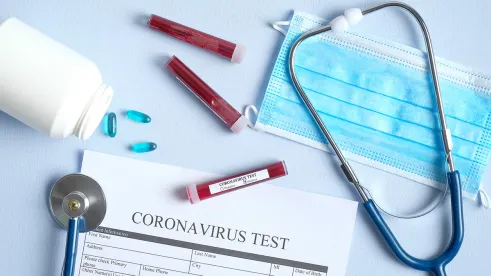On July 3, 2020, the U.S. Centers for Disease Control and Prevention (CDC) issued new guidance entitled “SARS-CoV-2 Testing Strategy: Considerations for Non-Healthcare Workplaces.” The new guidance recommends incorporating COVID-19 testing in five scenarios: (1) testing individuals with COVID-19-related symptoms; (2) testing asymptomatic individuals with a recent known or suspected exposure in order to control transmission; (3) testing asymptomatic individuals without a recent known or suspected exposure for early identification in special settings; (4) testing to determine when an individual may discontinue home isolation; and (5) testing for public health surveillance.
(1) Testing Symptomatic Individuals
The most relevant scenario for most employers is testing employees determined to be exhibiting COVID-19-related symptoms, such as when symptoms are identified during daily screening before employees enter the workplace. The CDC guidance suggests that employees with symptoms should be immediately separated from others and sent home or to a healthcare facility. If the employee tests positive, the employee should not come to work and should isolate at home until the employee satisfies the CDC’s criteria for discontinuing home isolation.
(2) Testing Individuals Exposed to the Virus
In addition to testing symptomatic employees, the CDC guidance envisions the use of viral testing of those in close contact with someone who has COVID-19 (e.g., in the non-healthcare setting, other employees who were within 6 feet of an infected employee for 15 minutes or longer). In this context, the CDC notes that such testing is often initiated by or conducted in consultation with state or local public health authorities. In addition, the CDC notes that “there may be a delay between the time a person is exposed to the virus and the time that [the] virus can be detected by testing, [and] early testing after exposure at a single time point may miss many infections.”
(3) Testing Individuals Who Haven’t Been Exposed to the Virus
The CDC suggests that a third application for COVID-19 testing is to help identify asymptomatic infected employees without any known or suspected exposure, particularly in workplaces where social distancing is difficult, remote settings where medical evaluation and treatment may be delayed, certain critical infrastructure settings, and workplaces that provide congregate housing to employees (such as fishing vessels, offshore oil platforms, and farm housing). In those scenarios, the CDC states that employers may consider different testing approaches, such as “initial testing of all workers before entering a workplace, periodic testing of workers at regular intervals, and/or targeted testing of new workers or those returning from a prolonged absence.” The CDC recommends that employers “have a plan in place for how they will modify operations based on test results and manage a higher risk of false positive results in a low prevalence population” prior to testing large portions of a workforce.
(4) Testing for Discontinuing Isolation
The fourth application for testing is to determine when an employee may safely discontinue home isolation (e.g., return to work). In this context, the CDC states that the determination of whether to use a symptom-based, time-based, or test-based strategy should be “made in consultation with healthcare providers and public health professionals.” (Note: Some state and local governments and public health authorities specifically advise against or even prohibit using a test-based strategy.) Notably, the CDC appears to soften its previous admonition that employers should not request a doctor’s note or test results in order to return an employee to work. In the new guidance, the CDC acknowledges that under the Americans with Disabilities Act (ADA), “employers are permitted to require a healthcare provider’s note to verify that employees are healthy and able to return to work.” Nevertheless, the CDC continues to warn that such documentation may be difficult to acquire from certain providers that “may not be able to provide such documentation in a timely manner.”
(5) Testing for Public Health Surveillance Purposes
The CDC states that COVID-19 testing also may be used for public health surveillance purposes in order to detect transmission hot spots or better understand disease trends in a workplace. According to the CDC, “[t]hese goals are consistent with employer-based occupational medicine surveillance programs[, which] may use testing to assess the burden of SARS-CoV-2 in the workforce … or evaluate the effectiveness of workplace infection control programs.” While the CDC notes that surveillance “should only be undertaken if the results have a reasonable likelihood of benefiting workers,” this scenario may be premature for consideration by employers absent further guidance from the U.S. Equal Employment Opportunity Commission (EEOC). At present, the EEOC’s guidance has approved of COVID-19 testing only in the context of determining if employees are safe to enter the workplace, and it is unclear whether a “surveillance” testing program would be deemed lawful under the ADA.
In addition to the discussion of the above outlined scenarios, employers may find the additional takeaways from the CDC guidance noteworthy:
-
The CDC states that its recommended testing strategies should be implemented as a supplement to other federal, state, and local health and safety laws applicable to the workplace and not as a replacement to other legal requirements. The CDC also notes that any testing should be carried out in a manner consistent with applicable employment laws, including with respect to employee privacy and confidentiality, and in accordance with published guidance from the EEOC.
-
The use of COVID-19 testing “may be incorporated as part of a comprehensive approach to reducing transmission in non-healthcare workplaces,” which includes other precautions, such as symptom screening and contact tracing, to help identify infected workers and take appropriate action “to slow and stop the spread of the virus.”
-
The CDC states that employees undergoing testing should receive “clear information” regarding (1) “the manufacturer and name of the test, the type of test, the purpose of the test, the reliability of the test, any limitations associated with the test, who will pay for the test, and how the test will be performed,” and (2) “how to understand what the results mean, actions associated with negative or positive results, who will receive the results, how the results may be used, and any consequences for declining to be tested.” The CDC also states that employees should receive “patient fact sheets” as part of the test’s emergency use authorization from the U.S. Food and Drug Administration (FDA).
-
The CDC notes that the U.S. Occupational Safety and Health Administration (OSHA) has issued interim guidance finding that COVID-19 is a recordable illness and outlining when an employer may be required to record an employee’s infection on the OSHA Form 300 log and/or report an employee’s illness.
-
The CDC guidance reiterates that while viral tests may be used to determine if an employee is currently infected with the virus, antibody tests should not be used as the sole basis to determine a current infection and “should not be used at this time to determine if an individual is immune.” Similarly, the EEOC recently issued guidance on antibody testing stating that under the ADA, employers may not use antibody tests as part of their employee screening programs to determine if employees are safe to enter the workplace.
Key Takeaways
This new guidance is a welcome development for employers seeking further insight into how they may implement COVID-19 testing in the workplace. While a helpful overview, the guidance is relatively high-level and raises additional legal questions, such as whether and to what extent an employer may unilaterally implement a “surveillance” testing program in the workplace without violating the ADA. Employers considering testing may want to review these guidelines carefully and evaluate additional requirements and guidance from the relevant state and local governments and public health authorities prior to implementing any large-scale testing program.




 />i
/>i

